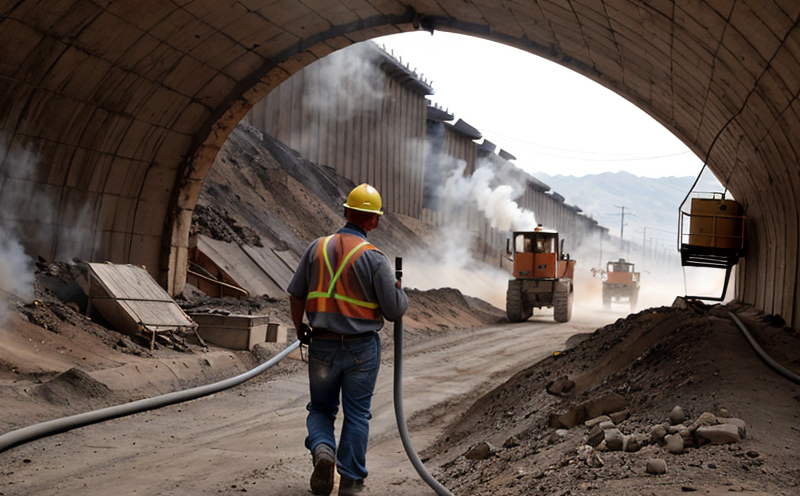NIOSH 7501 Quartz and Cristobalite in Dust FTIR Testing
The NIOSH (National Institute for Occupational Safety and Health) Method 7501 is a critical standard used to determine the concentrations of quartz and cristobalite in dust samples collected from mining environments. This method employs Fourier Transform Infrared Spectroscopy (FTIR) technology to identify and quantify these two crystalline silica compounds, which are known occupational hazards due to their potential to cause silicosis when inhaled.
Quartz and cristobalite belong to the group of crystalline silica, a common component found in many rock formations. In mining operations, these minerals can be released into the air as dust during processes such as drilling, blasting, or crushing. Exposure to high levels of respirable crystalline silica increases the risk of developing silicosis, an incurable lung disease that impairs breathing and leads to a reduced quality of life.
The NIOSH Method 7501 ensures accurate measurement of quartz and cristobalite in dust samples by providing robust protocols for sample collection, preparation, and analysis. The FTIR technique used in this method allows for precise identification based on the unique infrared absorption spectra characteristic to each mineral species. This approach not only enhances accuracy but also improves reliability over alternative methods like X-ray diffraction (XRD) or scanning electron microscopy-energy dispersive X-ray spectroscopy (SEM-EDS).
Sample preparation involves collecting dust samples using appropriate sampling devices designed to capture respirable particles efficiently. The collected dust is then transferred into suitable containers and preserved under controlled conditions until analysis can be conducted. Once ready, the sample undergoes thorough processing before being analyzed via FTIR.
The NIOSH Method 7501 includes detailed instructions for preparing reference materials that serve as standards against which unknown samples are compared during analysis. These references help ensure consistent results across different laboratories and over time, thereby enhancing the overall quality of occupational health monitoring efforts in mining operations.
In summary, compliance with this standard is essential for maintaining safe working conditions within mines where exposure to respirable crystalline silica could pose significant health risks. By adhering to NIOSH Method 7501, employers demonstrate their commitment to protecting workers' safety and well-being while also complying with regulatory requirements set forth by various governmental bodies.
Why It Matters
The importance of accurate quartz and cristobalite testing cannot be overstated given the severe health impacts associated with these minerals. Silica dust, particularly respirable crystalline silica like quartz and cristobalite, is classified as a carcinogen by OSHA (Occupational Safety and Health Administration). Excessive exposure can lead to serious respiratory diseases such as silicosis, lung cancer, and other chronic obstructive pulmonary disorders.
By implementing the NIOSH Method 7501 for quartz and cristobalite detection in dust samples, mining companies ensure they are meeting stringent occupational safety standards. This proactive approach helps prevent workplace accidents, reduces absenteeism due to illness, and fosters a safer working environment overall. Additionally, compliance with such methods demonstrates corporate responsibility towards both employees' health and regulatory expectations.
Moreover, accurate identification of these minerals in dust samples allows for better risk management strategies within mining operations. Employers can use the results from this testing to adjust ventilation systems or implement other measures aimed at reducing airborne silica levels. Such actions not only protect workers but also contribute positively towards environmental conservation efforts by minimizing pollution caused by excessive silica emissions.
In conclusion, NIOSH Method 7501 provides a reliable means of monitoring occupational exposure to respirable crystalline silica in mining environments. It plays an integral role in safeguarding worker health and ensuring adherence to international safety standards.
Eurolab Advantages
EuroLab offers comprehensive NIOSH 7501 quartz and cristobalite testing services tailored specifically for the mining sector. Our expertise lies in providing accurate, reliable analytical solutions that meet or exceed strict industry standards.
- State-of-the-Art Equipment: We utilize advanced FTIR instruments capable of delivering high-resolution spectra essential for precise identification and quantification of quartz and cristobalite particles.
- Experienced Technicians: Our team comprises highly skilled analysts trained in both sample preparation techniques and operational procedures required by the NIOSH Method 7501.
- Comprehensive Reporting: EuroLab provides detailed reports that include raw data, calculated concentrations of quartz and cristobalite, and comparative analyses with reference materials. These reports are invaluable tools for mine operators seeking to understand current risks and plan appropriate mitigation strategies.
- International Compliance: Our services align perfectly with global standards including NIOSH Method 7501 as well as other relevant regulations such as OSHA PELs (Permissible Exposure Limits).
At EuroLab, we pride ourselves on delivering top-notch analytical support to our clients in the mining industry. With a strong focus on quality and precision, we strive to help businesses maintain safe working environments while staying compliant with regulatory requirements.
International Acceptance and Recognition
- NIOSH Method 7501 is widely recognized by regulatory bodies across the globe, including countries like Australia, Canada, and various European Union member states.
- The use of FTIR technology ensures consistent results that are accepted internationally as a reliable method for identifying quartz and cristobalite in dust samples.
- Many mining companies outside North America also adopt this standard due to its reputation for accuracy and reliability.
This widespread acceptance underscores the importance of adhering to NIOSH Method 7501 when conducting quartz and cristobalite analyses, especially within the context of globalized industries where safety practices must be consistent worldwide.





